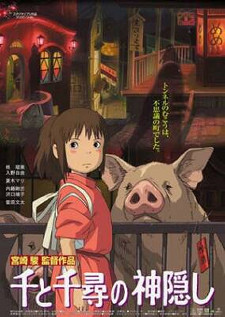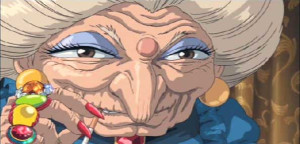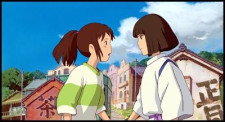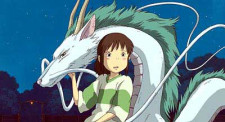Disney in the Classroom
Page 1 of 2
Disney in the Classroom
Spirited Away

Chihiro and her transformed parents
(c) Disney
Spirited Away causes strong reactions. The first time my children saw the movie they were terrified. Sam watched the entire movie from the hallway and Susie watched it through her fingers. When it was over Sam said it was "boring and scary" and Susie wanted to watch it again because "the Japanese people were interesting". Spirited Away seems to illicit these types of responses. People are either repelled by or fascinated by the movie’s exotic, often overwhelming images.
Personally I’ve been fascinated by Spirited Away for some time. This fascination started when I showed an ad for the movie to my Japanese exchange students. They became very excited and told me I had to see the movie. I found it intriguing that what was billed as "a movie for those who remember being ten years old and those who will be..." could have such an effect on high school students.

One bizarre character
(c) Disney
When I finally saw Spirited Away; I was overwhelmed by how strange it was. Chihiro, the main character, was apathetic and unattractive. The movie's setting (a bath house for spirits) was filled with bizarre characters and cultural references I didn't understand. While I did find Spirited Away's animation beautiful; I have to confess that the first time I saw the movie I had no idea what was going on.
I did, however, want to know what was going on. So I offered my exchange students extra credit to write essays explaining why the movie was important to them. What I discovered from these essays is that Spirited Away expresses a conflict in Japanese culture. The Japanese are a materialistic, modern people. They love technology, celebrities, shopping, and Disney Theme Parks. ;o) However, they also fear that their obsession with things is robbing them of their value as people. The students related to me that both Chihiro and No Face are representations of this fear. Chihiro because she has everything she wants but doesn’t care about anything; and No Face because he tries to obtain happiness by consuming everything around him. All three young ladies said the most important message of the movie is that Chihiro survives and returns to the human world a better person.

The result of No Face's misguided
attempt to find happiness
(c) Disney
My exchange students also mentioned that the movie used ideas from Shinto. (The religion or philosophy that most Japanese follow, usually in combination with Buddhism.) They also said that all of the films of Hayao Miyazaki made you "think about what is important". I knew very little about Shinto, and nothing about Mr. Miyazaki. So I did some research. What I discovered is that Shinto is a polytheistic religion; where each person or natural thing has divine attributes. (The Shinto saying- "Even the wishes of an ant reach to heaven" is one way to express this idea.) The goal of Shinto is to achieve purity by honoring the spirits of all things and all people. This includes honoring your ancestors; who some Japanese believe are now the spirits that inhabit places like rivers. Shinto teaches that if you do not honor the spirits you will become a person with no value. This is essentially Chihiro’s condition at the beginning of Spirited Away.


Haku (the boy and
later the dragon) is a river spirit
(c) Disney
